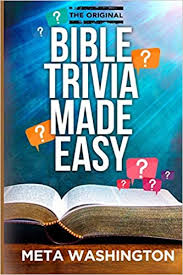
by Shari Noland | Sep 21, 2021 | Headline News |
Where did Elijah go when he fled from Jezebel?
How many songs did King Solomon write?
Who was the first person in the Bible to bake a cake?
Answers on the tip of your tongue? Not so sure? Want to phone a friend? Every Tuesday, Meta Washington, Midday Host of Kirk Franklin’s Praise, SiriusXM Channel 64, keeps people on their top Bible game with trivia on her radio show. The popularity of the “Tuesday Trivia,” sprinkled in-between Gospel songs throughout the day on air, also inspired her to write “Bible Trivia Made Easy,” a themed book of bible questions with illustrations, photos.
“I knew it was a big thing when one time we had a famous artist who I would say was on and interviewing and a real big to do. And his interview was somehow placed over the time when I usually start asking the questions, and somebody said, ‘Is there going to be trivia today?’ And I thought, ‘Wow…alrighty,'” said Washington, who lives in Brooklyn, NY.
Washington says it started with just a few people responding but has grown so popular that she now has “Bible Scholars,” a mix of new people to the Word, along with ministers and Bishops. They interact with each other on her social media channels, cheering each other on.
“It’s a huge, big thing that people are doing,” said Washington. “People were saying, ‘Wow, I was so blessed because I didn’t understand much of the Word before.’ I let the people have some fun, take the tension out of it. I tell them, ‘Hey, don’t beat yourself up if you didn’t get it right. Consider the blessing. If you learn something new from the Word of God.”
Here’s how it works on her radio show. She’ll throw out a question, people will email her their answers, and she’ll call out the names on the air of those who got the answers right. Although her radio show listeners inspired the idea behind creating the Trivia book, she was also motivated by her personal experience in church Bible Study. Washington, a Brooklyn native whose family is from Barbados and Jamaica, grew up Episcopalian, but she moved to the Baptist church as an adult. An eager learner, she was dismayed to see how people were interested in hearing the pastor or Bible study teacher speak but were intimidated when asked to answer questions.
“They were worried that one of their church peers might realize or think, ‘They don’t really know. They’re not as close to God as I am because they don’t know as much about the Bible.’ So the pastor would ask questions, and people would sit there in dead silence. And I’m like, ‘Well, don’t you want to ask? Don’t you want to know?’ They were just afraid,” said Washington.
With that in mind, you might think the idea of being hit with a Bible trivia book could be equally as intimidating. But Washington’s book is a fun, and as its name states, easy read. The 300 questions came from six years of trivia on air. Washington says she attached a fun theme to each question, such as “Compose Yourself,” which appears right before the question about the number of songs King Solomon wrote,” to help people learn by association. And unlike many other trivia books, her book is organized by sections and topics and not skill level, such as beginner, intermediate, or expert.
“The Bible isn’t written like that, and I don’t do it like that on the air. You learn it as you receive it. And I think to try to dumb it down for people doesn’t help them. While you’re participating, you are learning, and you’ll be surprised, you know the more complex parts of the Bible as well as the parts that are, yeah, they’re easy.”
Washington also has a book in development called “On the Third Day,” which includes pictures of nature she’s taken over the years that appear to tell scripture stories.
“Generally, we talk about ‘on the third day’ Jesus rose, but on the third day, God created trees and plants, and all of what we know is nature. And I said, ‘It has its own story to tell.’ And in this book, I am allowing nature to tell its story in its way,” said Washington. “I have an image of a type of plant that looks like flames. It looks like little fur, and I have a patch that’s all red, and it looks like flames. I had the story of Shadrach, Meshach, and Abednego. They are in the fiery furnace. I had the scripture there, you have the picture, and you can see the imagery.”
Even with the newly themed picture book on the horizon, Washington’s still focused on trivia, too. She self-published Bible Trivia Made Easy in September 2020 on Amazon.com, and there is a new edition on the way. Yet even with her good intentions of just wanting to help people, there have been a few naysayers. One listener accused her of making fun of the Word of God, telling her to just stick to the music.
“I don’t want the listeners ever to think that I am making trivial of the Word of God when I say trivia. Bible trivia is meant to help people. It’s one thing to memorize Psalm 23 and be able just to regurgitate it back. But when you learn something new after you have been studying the Word for more than ten years, that’s the real knowledge and the nugget there.”
Trivia Question Answers:
Elijah traveled forty days and forty nights until he reached Horeb, the mountain of God (1 Kings 19:3-8)
King Solomon wrote 1,005 songs (1 Kings 4:29-34)
Sarah was the first person to bake a cake in the Bible. (Genesis 18:6)

by Anthony Jones II | Sep 19, 2021 | Headline News, Prayers & Devotionals |

I stopped using instagram about two years ago. Then, I stopped using Twitter as my new year’s resolution. On some level, I realized that these apps were consuming my time and making me a less happy, more anxious person in return. As an outsider looking in, the amount of times that someone in my life has had a relative or parent become transformed through social media grows with the days. It seems almost ironic how a technology that was supposed to connect people more effectively has, in some respect, begun tearing them apart. Being connected to others is great, but no one stopped to consider what kind of relationships could be fostered online. The resulting digital landscape can often leave people feeling more isolated, self-conscious, and valueless than anyone could have anticipated. However, there is always hope. The bible offers keen advice for fostering not just connection, but true community.
Unlike most of my peers, I actually didn’t get consistent access to the internet until I was in high school. For better or worse, this distinction provides me with a certain level of perspective. I was someone who went from seeing the world plainly to someone dropped into a new era where performance and reality start to blend together. I watched as friends and acquaintances grew more and more involved with the technology in their lives. Some people were able to adapt and use this new digital paradigm to their benefit, others struggled to try and gain footing in this new age. The only common thing linking these people and their relationship with technology is the fact that digital social relationships would become more and more important as time marched onward.
When the pandemic hit, no one saw just how much technology would become a central facet of everyday life. Classes went online at my college near the end of the school year. I assumed we would be back next fall. Then fall came, and next winter, spring and so on. During that time, I spent a lot of time talking with friends and family members online. Even so, I could not abate a growing and pervasive sense of loneliness, a sentiment I’m sure others experienced during this period in time as well. Being limited to mainly digital forms of communication began to expose just how much of the digital world exists as a reality unto itself. The internet is a place where anything is possible, but also a place where authenticity is hard to come by. It’s nice to be seen and heard, but fully appreciating others for the qualities that make them unique is almost impossible when you also have to cut through the fog of artifice that pervades social media.
The biblical solution to this problem of connection despite obfuscation is eloquent and simple. Love thy neighbor as thyself. Matthew 22:39 is one of the most famous verses in the bible but it is also one of the most important. In the final days of his life, Jesus visits the Hebrew Temple in Jerusalem and stops to speak to a crowd of Pharisees, Sadducees, and lawyers. During the speech, a man asks Jesus what the most important commandment is. The man was a lawyer and a religious man which alludes to the personal and cultural significance of this question. Jesus replies simply “ Thou shalt love the Lord thy God with all thy heart, and with all thy soul, and with all thy mind. This is the first and great commandment. And the second is…thou shalt love thy neighbour as thyself.”
The first part of this statement has become so foundational to Christian belief that it is almost a given, but the second and equally important part of the statement can be harder to put into practice. Yet, out of the hundreds of laws that make up the Hebrew legal system, these two laws were selected as the most important. One cannot help but ask why?
At the heart of this plain statement lies a simple emotion, empathy. You might not know everything about the situation that another person is in, their life could be great or incredibly hard. It is easy to focus on disparities like these when empathizing with others but this is merely a distraction. We are all human beings living here together on this planet, we are more alike than we realize. On that most basic level, we are connected. We’re born, breathe, eat, sleep, and eventually pass away. Through this experience of living we are connected and as followers of Christ, this experience is precious since it was given to us when God first breathed life into Adam.
One of the reasons that I believe we are first instructed to love God with all of our hearts is so that we can learn our value as creations of God. One the other hand, the reason that we are instructed to love our neighbor as ourselves is because they too are creations. Appreciating others as not just sources of affirmation, love, or entertainment, but as unique individuals created and loved by the same God who created us provides a pathway to more genuine, authentic relationships both online and in life.
by Jelani Greenidge, Urban Faith Contributing Writer | Sep 17, 2021 | Entertainment, Headline News, Jelani Greenidge |
Here at UrbanFaith, we believe that the recent past is a neglected element of black history. Jelani Greenidge, worship musician and music connoisseur, took a look back at some of the most momentous gospel music recordings of our era.
Commissioned, “Victory”
Go Tell Somebody, Light Records, (1986)
I can’t talk about back-in-the-day gospel music without talking about Commissioned. For my parents’ generation, their watershed gospel songs, the ones that strike them with nostalgia, are the Walter Hawkins or Andrae Crouch recordings from the late 60s and 70s. But for me, a (formerly) young member of Generation X… it’s Commissioned, all the way. And man, does this one take me back.
It is tremendously fitting that this song opens with a Fred Hammond bass lick, because Fred was one of the main creative forces of the group, alongside keyboardist and arranger Michael Brooks. And though the album from which this sprang was not their first, it was the one that really put them on the map.
One of the funny things about growing up black in Portland, Oregon is that even though there was a tightly-knit black community in my area, we were a lot smaller in number compared to other cities. And certain trends, dance moves, fashion, etc. took longer to show up here.
Consequently, there were a lot of cultural gaps in the overall awareness of my peers, especially my white peers. There were things they just didn’t understand that I thought would be obvious to everyone. (I mean, didn’t everyone grow up in my family? Oh wait…)
Nowhere was this more apparent than with my enthusiasm for the music of Commissioned. In the late 80s and early 90s, when a new era of male R&B groups was dawning, led first by New Edition and then later Boyz II Men, I kept hearing over and over, not only in their music but also in interviews and liner notes, that virtually all of them had been inspired, on some level, by Commissioned. (It was either them or Take 6.)
So why were Boyz II Men mega-famous, and not Commissioned, my pubescent mind wondered. And the answer came to me, many years later, as I pondered the meaning to the song that had been my jam for so long.
See, in the chorus, when the guys sing, “Victory, victory shall be mine”… that’s God talking. It’s not a celebratory, name-it-and-claim-it type thing. It’s actually a challenge to remain calm and not take matters into our own hands.
Hold your peace, vengeance is mine / enemies will bow down in due time / hold your peace, I will fight your battles / victory, victory shall be mine
These words are all Scriptural paraphrases, taken from passages like 2 Chronicles 20:15, Romans 12:19, and Deuteronomy 32:35 – which is probably why this song has endured for so long.
So relax, crank up the speakers, and take the time to look for God’s activity in your life while you bump this Gospel Throwback.
by Urban Faith Staff | Sep 16, 2021 | Headline News, Prayers & Devotionals |
Yom Kippur is a Jewish holiday that is also known as the Day of Atonement. It is the most important Jewish holiday of the year and is observed by Jewish congregations around the world from the most orthodox to the most progressive. On Yom Kippur faithful Jews present themselves to the Lord in fasting, prayer, scripture reading, and most of all repentance. But many Christians have no idea what Yom Kippur is or where it is from in the Bible. The following excepts from our UrbanFaith Magazine lessons help to provide some clarity about Yom Kippur’s Biblical foundation.
Read Leviticus 16:11-19 for the full scripture reference.
The Day of Atonement was for atoning of all the Children of Israel’s sins and failures, and allowing for God to dwell among them. Only on this day was the high priest allowed to enter into the veiled Holy of Holies, the holiest of areas, without risking death. While sin separates man from God, His love does not want this separation to remain. In these verses, the high priest now sacrifices a goat as a sin offering for the people. This sacrifice of the goat represents the blood sacrifice required to satisfy the righteousness and justice of God on behalf of the people. In Judaism, sacrifices are no longer offered since the temple no longer exists, but Yom Kippur remains a day of repentance which is coupled with fasting as a way of expressing humility and remorse before God and community. Thus, God no longer requires sacrifices in Judaism, only a humble heart. It is important to understand that God’s love cannot be expressed unless His justice is satisfied.
One purpose of the Day of Atonement was to cleanse the tabernacle of the uncleanliness introduced into it by the unclean worshipers. The rituals we see here allowed for God’s continual presence among His people. For the second time, the high priest enters the Holy of Holies and sprinkles the blood of the goat on and in front of the mercy seat and over the altar. Now we see that he is atoning not only for the people, but also the place itself. For both Jews and Christians, it is no longer the Old Testament temple or tabernacle, but our entire beings that are the tabernacles in which God dwells. For Christians, the sacrifice of Jesus atoned for our sins and cleansed our tabernacles—our bodies, souls, and spirits—in the sight of God.
God provided the Day of Atonement so that His flawed and often sinful people could “ offer your bodies as a living sacrifice, holy and pleasing to God—this is your true and proper worship” (from Romans 12:1, NIV). Pray and ask God to help you in this area. Commit to believing that not only does God love and accept you the way you are, but more importantly, He is ready to use you without hesitation or exception. Tell God that you are ready for Him to use you, today.
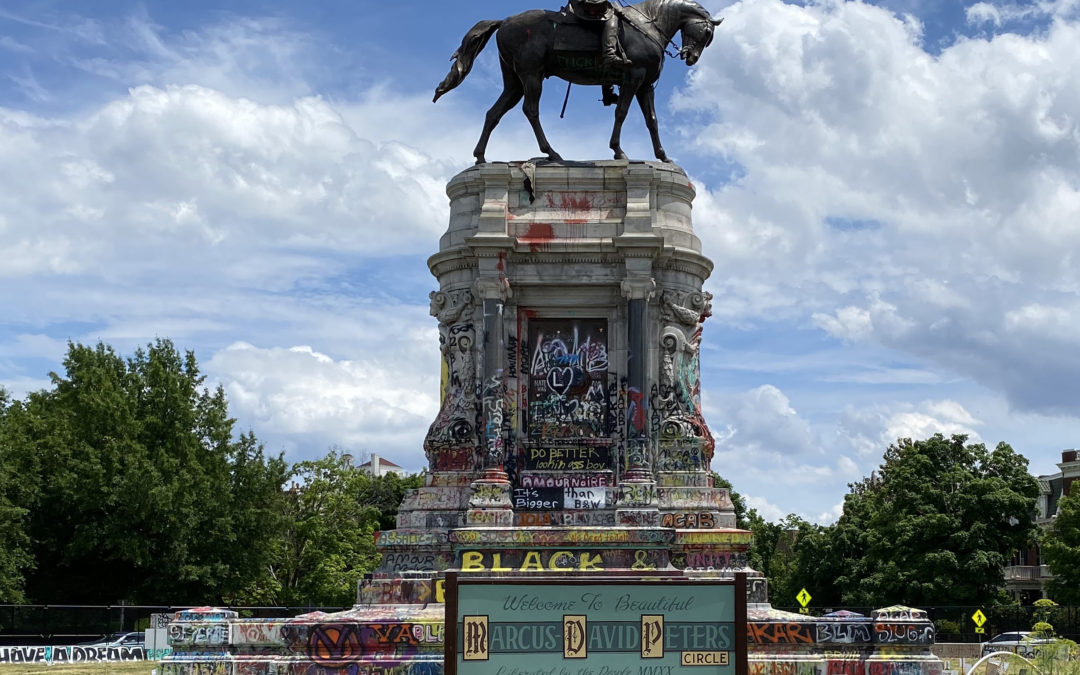
by Robert P. Jones, RNS | Sep 15, 2021 | Black History, Commentary, Headline News |
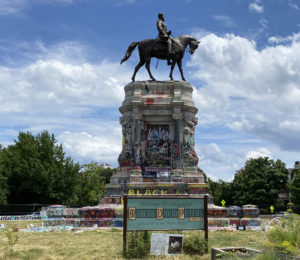
The monument to Robert E. Lee on Monument Avenue in Richmond, Virginia, after 2020 racial justice protests. Photo by Robert P. Jones
(RNS) — The last Confederate monument still standing on Richmond, Virginia’s Monument Avenue, the massive tribute to General Robert E. Lee, was removed on Wednesday (Sept. 8).
A 21-foot bronze sculpture mounted on a massive 40-foot pedestal, it was primarily funded and conceived by the Ladies’ Lee Monument Committee, a predecessor to the United Daughters of the Confederacy, which has its headquarters in Richmond to this day. The statue’s dedication on May 29, 1890, was accompanied by three days of events (including a choral performance by the Young Men’s Christian Association) that drew an estimated 100,000 people.
Beside the statue, special stands were constructed to contain hundreds of white children wearing red, white and blue who were arranged to create a living Confederate battle flag.
The title of the Richmond Times editorial that week captured how the city’s white residents understood the meaning of this new landmark: “Conquered Though Not Vanquished.” As historian Karen Cox summarized it, “This was not just a monument to the region’s most cherished hero; it was about the restoration of Confederate men’s honor.”
It was also a declaration of a war on the terrain of culture and politics as Virginia, like many Southern states, threw off the reforms of Reconstruction and set up legal and cultural systems of segregation and the suppression of voting by African Americans.
The Lee monument was the down payment by the city’s white elite on a multidecade effort to create the broad leafy outdoor corridor that would eventually be punctuated by five traffic circles, each containing a massive monument to the Confederacy.
Between 1890 and 1930, the wealthier white residents not only moved their homes but also rebuilt at least seven of their churches out along Monument Avenue in the shadow of these monuments. The architectural interplay between monuments dedicated to the Confederacy and sanctuaries dedicated to God performatively expressed the motto emblazoned on the five-story column behind the statue of Jefferson Davis: “God will vindicate.”
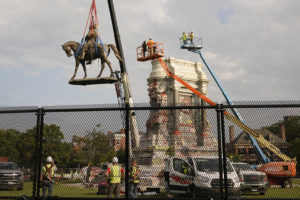
Over the past few years, I’ve spent several weeks in Richmond, conducting research in the archives of the UDC for my book “White Too Long” and tracking the unfolding drama as the city and its churches are attempting to extricate themselves from the Lost Cause narrative and create a new story that looks to the future, rather than the past. The juxtapositions, and contradictions, can be jarring.
When I first visited in July 2019, the city had just renamed one of its central streets — one that historically fronted the national headquarters of the UDC along with “Battle Abbey,” originally built to hold Confederate reliquary and now the Virginia Museum of History & Culture — after native son and international tennis star Arthur Ashe Jr.
As a youth, Ashe had been banned from playing tennis on Richmond’s public courts because of his race. As an adult, he dedicated his life off the court to international civil rights work, philanthropy and scholarship.
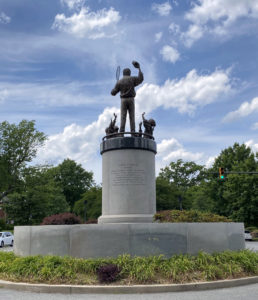
Monument to tennis star Arthur Ashe Jr. along Monument Avenue in Richmond, Virginia. Photo by Robert P. Jones
That summer, the VMHC had hung large banners of Ashe outside the building, and there were images of him on large placards along the sidewalk. Just 30 feet or so down the sidewalk in front of the UDC building, half a dozen pro-Confederate protesters had hoisted large Confederate battle flags on makeshift poles over placards that read, “Save our monuments.”
When the UDC archivist handed me her business card, it had already been updated to show their location on “Arthur Ashe Boulevard.”
Interestingly, this is not the first time that Richmond’s residents have called on Ashe to oppose Confederate forces in Richmond. In 1996, three years after his untimely death, the city placed a memorial to Ashe on Monument Avenue. The 12-foot-tall statue, resting on a 21-foot pedestal, sits on a traffic circle just beyond the last of five Confederate monuments along the venue. About 500 people attended the unveiling of the monument, with some holding up Confederate flags in protest.
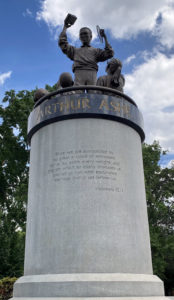
Monument to tennis star Arthur Ashe Jr. along Monument Avenue in Richmond, Virginia. Photo by Robert P. Jones
When I visited in 2019, I was struck by how diminutive Ashe seemed in the context of Monument Avenue. His likeness, anchoring one end of the avenue, was roughly half the size of the Lee, Davis and Jackson monuments nearer the city center. But when I revisited this past summer, the statue of Ashe, with a book held high in his right hand and a tennis racket slightly lower in his left (a pose explicitly requested by Ashe himself to emphasize the importance of education) loomed larger.
Four of the five Confederate statues were removed by the city in response to the Black Lives Matter protests of 2020. The statue of Lee had been covered with graffiti that transformed it into an internationally recognized site of performance art for racial justice.
For the first time in 130 years, a trip down Richmond’s Monument Avenue will not entail an involuntary Lost Cause pilgrimage. Rather — and this is the surprisingly moving experience I had biking down that street this past July — the empty pedestals will stand as silent indicting witnesses to the past valorization of white supremacy by a city’s white leaders and churches.
The monument to Arthur Ashe Jr. prominently incorporates a biblical inscription from the New Testament’s Letter to the Hebrews on the front of its pedestal: “Since we are surrounded by so great a cloud of witnesses, let us lay aside every weight, and the sin which so easily ensnares us, and let us run with endurance the race that is set before us.”
I don’t know everything Ashe and his family had in mind with that selection, but today it seems fitting for the last man standing on Monument Avenue.
(Robert P. Jones is the CEO and founder of PRRI and the author of ” White Too Long: The Legacy of White Supremacy in American Christianity.” This article was originally published on Jones’ Substack #WhiteTooLong. Read more at robertpjones.substack.com. The views expressed in this commentary do not necessarily reflect those of Religion News Service.)

